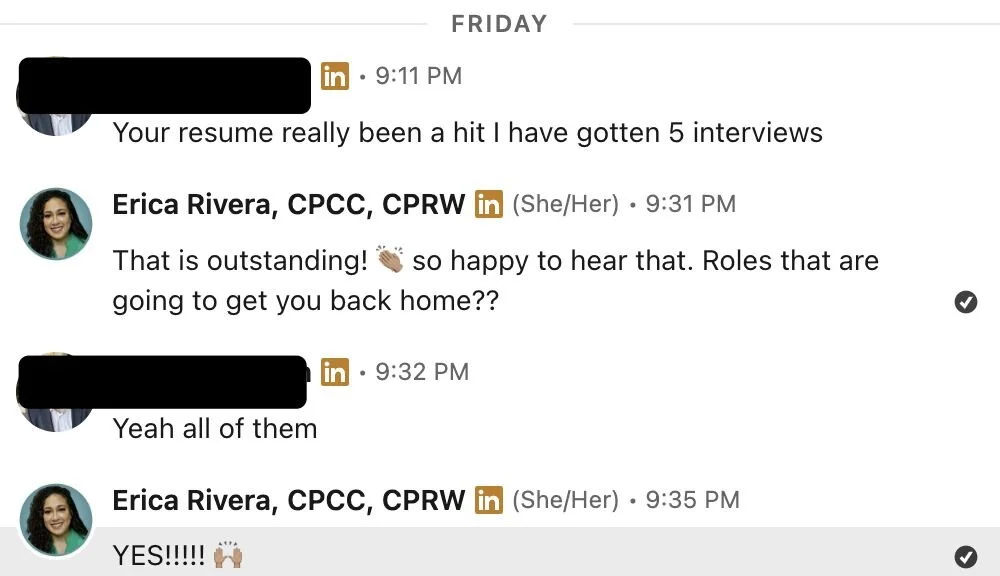Why Changing Jobs After 20 Years Isn’t as Scary as You Think
Changing jobs after 20 years of work experience feels terrifying. No sugarcoating it. You build your whole identity around a career, a title, a company... and then one day, you start wondering if you’ve outgrown it.
I get it because I’ve seen it firsthand. One of my clients hadn’t interviewed in over two decades. She thought no one would want her experience, that she was "too dated" for today's job market. Fast forward two weeks after we repositioned her story? She had five interviews lined up. Five.
So if you’re here wondering if it’s too late for you, or if starting over is your only option—let’s get one thing straight: you are more valuable than you think.
And no, you don’t have to start from scratch.
Let’s walk through exactly how you can make your move without burning down everything you’ve built.
Is it okay to switch different jobs after a year of experience?
Short answer: yes.
Long answer: if the job isn’t growing you, paying you right, or aligning with your future goals—staying is riskier than leaving.
Hiring managers today care more about what you bring to the table than how long you sat at one. Companies are looking for impact, not just tenure. So even if you only spent a year (or less) in a role, it’s about how you tell your story. Focus on what you learned, how you grew, and why you're ready for the next step.
One of my clients left a role after 11 months and still landed a promotion and a pay bump at her next job. Why? She showed how much she'd accomplished during that time instead of apologizing for the short tenure.
Why People Hesitate to Change Jobs After 20 Years
Changing jobs after 20 years can feel like trying to climb a mountain barefoot. The fear is real.
Here’s what I see trip people up the most:
Fear of starting over.
It’s terrifying to think you’ll have to rebuild from zero—but that’s almost never true.Worry about being “too old” or “outdated.”
Age isn’t the disqualifier most people think it is. Lack of storytelling around your skills is.Feeling invisible on job boards.
Spoiler: Job boards are a black hole. Smart networking and personal branding get you hired.Not knowing how to reframe skills.
Just because your title says one thing doesn’t mean your value ends there.Technology gaps.
Yes, tech has changed. But adaptability is a much bigger flex than knowing the latest software.
Truth is, companies want leaders, problem-solvers, and strategic thinkers—experience still wins when it's positioned right.
How to Reframe 20 Years of Experience as an Asset
Here’s where the real shift happens.
You’re not “old.” You’re not “outdated.” You’re carrying decades of depth. And that is rare.
When we reframe your experience, we focus on:
Leadership over longevity.
It’s not “I’ve been here forever.” It’s “I know how to guide teams through change.”Adaptability.
Highlight how you've evolved with your industry. Bonus points for examples.Outcome-focused wins.
Instead of “managed a team,” say, “led a team that increased revenue by 30% in 18 months.”Depth of expertise.
You didn’t just show up. You built things. You solved problems others couldn’t.Mentorship & big-picture thinking.
You’re not just doing tasks—you’re shaping strategy.
One client I worked with had spent 18 years at the same company. She thought nobody would want her. After we repositioned her as a strategic advisor who had navigated multiple company-wide transformations, she got two leadership offers within a month.
What Changed? The Power of the SSIP™ Framework
When one of my clients was stuck, I asked him one simple thing:
“What’s your SSIP™?”
Here’s how it works:
Scope:
What problem were you solving? Companies want context. Were you fixing a broken process? Leading a turnaround?
Scale:
How big was it? Managing five people is different from managing five hundred. Paint the picture.
Impact:
What changed because you were there? Numbers, wins, real movement.
Proposition:
Why does it matter now? Show how your past wins solve their current problems.
Once he used SSIP™, everything shifted. He wasn’t just another candidate with a long resume. He was a solution.
And guess what? That's what hiring managers are buying.
How to Update Your Resume When Changing Jobs After 20 Years
If your resume still opens with an “Objective” statement, it’s time to let that go.
Here’s what actually works:
Lead with a strong Professional Summary.
One that sells your leadership, wins, and industry savvy right out of the gate.
Focus on the last 10-15 years.
Earlier experience? Summarize it in one line if needed.
Showcase major achievements.
Skip listing duties. Show what changed because you were there.
Quantify everything.
How much revenue? How much growth? How many teams?
Tailor to each job.
Keywords matter. Match your language to the role you want.
I had a client who hadn’t touched her resume since 2001. After we updated it with a crisp summary, focused bullet points, and some strong quantifiable wins, she booked three interviews off her first five applications.
How to Prepare for Modern Job Interviews
Today’s interviews are all about storytelling.
No more rattling off your job duties like a grocery list.
Here's the shift you need:
Practice behavioral questions.
"Tell me about a time when..." will come up. Prepare your stories.
Craft your career story.
Why are you making a move now? Own it. Don’t apologize.
Speak about tech without panicking.
You don’t have to know every tool, but you do need to show you’re willing to learn.
Use the STAR method.
Situation, Task, Action, Result. Keep it tight, keep it real.
Show you’re excited about growth.
They’re hiring for the future, not the past.
One client told me, "I thought interviews were about not messing up. Now I realize they're about showing how I'd make their life easier."
Exactly.
How to Leverage LinkedIn to Accelerate Your Job Search
LinkedIn isn’t optional anymore. It’s the front door to your career opportunities.
First step? Update your headline. It should reflect where you’re going, not just where you’ve been.
Your "About" section should tell a story — who you are, what problems you solve, and what you're excited about next.
Start posting or engaging. You don’t have to go viral. Share a tip you learned, a career insight, or an article that resonates. Activity breeds visibility.
And for the love of all things career growth, connect with real people—recruiters, hiring managers, peers. Relationships open doors that job boards never will.
One client started posting once a week after our work together. In a month, she had three recruiters reach out—without applying to a single job.
Success Story: 5 Interviews in 2 Weeks After 20 Years in the Same Role
This client came to me convinced no one would want her after 22 years in one company.
She wasn’t getting calls back. Her resume read like a history textbook. She felt stuck, invisible, and outdated.
Once we used SSIP™ to reframe her experience? Once she started telling stories of leading transformations, mentoring teams, and driving results? It was like flipping a switch.
Within two weeks, she had five interviews—including with companies she thought were "out of her league."
Now? She's moving back to her hometown with three job offers in hand.
The only thing that changed was how she told her story—not who she was.
FAQs About Changing Jobs After 20 Years
-
Absolutely. Companies today value growth and adaptability. Staying too long without growth can actually hurt you more than moving.
-
Focus mainly on the last 10-15 years. Summarize earlier roles if they support your story, but don’t list every job detail from the 90s.
-
Professionally and clearly. A simple resignation letter, a meeting with your manager, and enough notice to leave on good terms. Then, shift your focus to what’s ahead.
About Career Coach
Hi, I’m Erica Rivera, career coach and founder of Career Coaching Diva. I know what it’s like to face a tech layoff—I lived it. When I lost my job at Google, I refused to let it define me. Instead, I took control, pivoted strategically, and built a career on my terms.
Now, through Career Coaching Diva, I help professionals do the same—because you don’t have to start over. You just need the right strategy.
Let’s map out your next career move. Book a Career Discovery Call today
You’re More Ready Than You Think to Change Jobs After 20 Years
You’ve led teams. You’ve solved hard problems. You’ve stayed adaptable without even realizing it.
You don’t have to "start over." You just have to start telling the right story.
Use SSIP™. Update your resume and LinkedIn. Practice sharing your wins. Position yourself like the leader you already are.
The interviews, the opportunities, the offers—they’re waiting.
But first, you have to believe that you’re not stuck. You’re just getting started.





